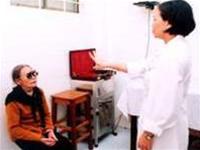Night blindness, or difficulty seeing clearly at night, is not a disease in itself but rather a symptom of various underlying conditions. Many individuals who have difficulty seeing objects up close also report challenges when viewing in low light; however, this generally falls within the realm of normal vision rather than a pathological condition.
 |
| Vision test for the elderly at the Central Eye Hospital (Photo: TTO) |
Retinitis pigmentosa, with an incidence rate of approximately 1 in 3,000 to 1 in 5,000 depending on the country, has been known since 1744, first described by Ovelgun. In France, there are about 20,000 people suffering from this disease, with an additional 350 new cases diagnosed each year. Retinitis pigmentosa may also be associated with disorders of the nervous system, ears, and musculoskeletal system, as seen in Usher syndrome. A range of retinal diseases and syndromes related to genetics or drug toxicity often present with early symptoms of night blindness. Additionally, certain optic nerve disorders and, notably, vitamin A deficiency can also lead to this condition.
How can you or healthcare professionals identify someone with night blindness? Simple methods such as asking questions and observing behavior can be very effective for early detection of night blindness. These individuals often have perfect vision during the day, just like the rest of us. However, when dusk falls or at night, they may become clumsy, awkward, prone to falls, or cause accidents, leading others to mockingly label them as “clumsy.”
Due to societal prejudices and personal awareness of their shortcomings, these individuals may feel sad and withdrawn from others as night approaches. This is particularly true for children, who may refrain from playing with peers, opting to stay in one place to avoid breaking things and facing parental reprimands. More specific tests to confirm this issue, such as light-dark adaptation tests, electroretinograms, and visual fields, will be conducted in specialized eye clinics. Specific diseases related to night blindness will be diagnosed, but what about treatment?
Since the causes of night blindness are often related to genetic disorders, and some remain unknown, treatment options are not always clear. The first line of treatment often discussed is vitamin A. If night blindness resolves with vitamin A treatment, it indicates that the patient was vitamin A deficient. Treatment with vitamin A at a dosage of 15,000 IU per day, or even better, in combination with 400 IU of vitamin E per day, has shown a significant ability to prolong the survival of retinal cells compared to the control group in retinitis pigmentosa patients.
Vitamin A has been widely used to support the treatment of respiratory and digestive diseases. Beyond that, it is also prescribed by ophthalmologists during treatment processes. Today, vitamin A is readily available on the market, found in VIDOCOM capsules, which are recommended by eye specialists for all cases of night vision disorders.
The effects of DHA (omega-3) and calcium channel blockers are also recommended for inherited retinal diseases associated with beta phosphodiesterase enzyme disorders.
Retinal transplants, artificial retinas, and even innovative gene therapy technologies have shown initial successes in animal studies. We must patiently await results in human trials.


















































